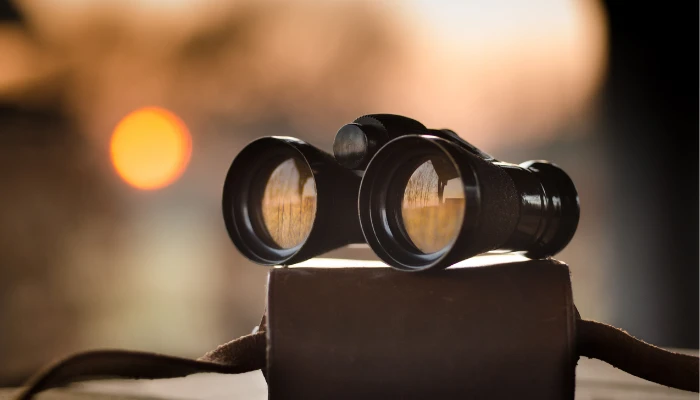This post may contain affiliate links which means I may receive a small commission for purchases made through the links. Learn More
Have you ever wondered what the numbers on binoculars mean? I certainly did when I first started looking for a pair to buy. According to my experience, many people, especially the newsies don’t know anything about the numbers, and specifications.
If you’re in the market and looking to buy a nice pair of binoculars, then the numbers written on the boxes of binos can be confusing. But without understanding the number, you won’t be able to know about the specifications, and capabilities of binoculars.
Two primary numbers on binoculars indicate the magnification and size of the objective lens. The first number represents magnification power, whereas the second number indicates the objective lens size.
In this guide, I’ll explain all the numbers that are related to binoculars and give you in-depth insight. So, stay connected till the end. Let’s get started.
Primary Number Written on the Box of Binoculars to Show Specifications
When you purchase a pair of binoculars, you will notice a set of numbers written on the box. These numbers indicate the specifications of the binoculars and are essential in helping you select the right pair for your needs.
No matter, if you’re a newbie or an experienced outdoor campaigner, knowing what the numbers mean, can help you make an informed decision and get the most out of your binoculars. In this section, I will discuss the primary number written on the box of binoculars and what it means.
1- Magnification
The first number written on the box of binoculars is the magnification. In my previous guide, I have already explained the magnification power in detail. However, this number tells you how many times closer the object will appear when viewed through the binoculars.
For example, if the binoculars have a magnification of 10x, the object will appear ten times closer than it would to the naked eye.
Let me explain it in a more simple way. If the object is 1000 yards away from you, then by using binoculars having 10x magnification power, you’ll be able to see the object if it is just 100 yards away from you.
Many people believe that the higher the magnification power, the better the visual quality of binoculars. It is just a myth that is totally wrong.
Keep in mind that higher magnification does not always equate to better image quality. Higher magnification can make the image appear shaky, and it can be challenging to keep the object in focus.
However, when you choose binoculars with higher magnification power, you tend to see farther. But you actually compromise on the stability of visuals that you get through these binoculars.
Special Note: Higher magnification makes the binoculars very sensitive to small movements of hands. So, during use, when you move slightly, the visual gets too insatiable, making it harder to see clearly.
2- Objective Lens Diameter
The second number in the box of binoculars is the objective lens diameter. The size of an objective lens is very important as it directly affects the visual quality and overall performance of binoculars.
This second number tells you the size of the front lens of the binoculars in millimeters. The larger the objective lens diameter, the more light the binoculars can gather, resulting in a brighter and clearer image.
However, larger objective lens diameters also mean the binoculars will be heavier and bulkier. So, it is very important that you keep the balance between the visual quality and the size of binoculars.
Binoculars that have bigger-sized objective lenses are hard to carry along when you are on a long hunting trip or use binoculars for extended duration due to their bigger size, and weight. Don’t go with too big size and also avoid small-sized binos as they don’t give you better visuals at lowlight conditions.
Explanation of Other Numbers Used in Binoculars
In the above section, I have guided you about the numbers explaining magnification, and objective lens size. These numbers are usually written on the front of binoculars boxes that buyers see.
However, there are many other numbers that are usually written in the manual guide or instructions book which are usually overlooked. In the section below, I will explain other numbers that are also used to explain the specification of binoculars.
1- Eye Relief
Eye relief is one of the most important things that you must know about especially if you’re considering buying binos. Don’t you know about eye relief? It is the distance between the eyepiece and your eye when the entire field of view is visible.
Keep in mind that eye relief is very important for those who wear glasses because it determines how close your eye can be to the eyepiece while still seeing the entire field of view.
Eye relief is typically measured in millimeters and can range from 8mm to 20mm or more. However, I recommend you to go with binoculars that offer eye relief longer than 15 mm as it will give you a comfortable viewing experience.
2- Field of View
Another important number that is used in explaining binoculars’ specifications is the field of view. It is the width of the area visible through the binoculars at a certain distance. It is measured in degrees or feet at a certain distance.
A wider field of view means you can see more of the surrounding area, while a narrower field of view means you see less. The field of view can vary greatly depending on the magnification power.
With higher magnification power, then the field of view will be narrower and vice versa. I recommend you choose binoculars having a field of view of at least 350 feet or more than that.
3- Exit Pupil
The size of the objective lens and exit pupils are two important things that make a binocular good for lowlight conditions. Compromising on any of these two factors means that you’re compromising on the lowlight usability of binoculars.
The exit pupil is the diameter of the beam of light that exits the eyepiece of the binoculars. The better and bigger the exit pupil, the better the binoculars will be in lowlight conditions.
It is measured in millimeters and is determined by dividing the objective lens size by the magnification. For example, in 10×50 binoculars, you get an exit pupil of 5 mm.
4- Close Focus
Do you love getting close details of the targeted objects? Are you buying binoculars for viewing smaller creatures and getting their details? If your answer is yes, then you must understand to consider close focus seriously. Close focus is the closest distance at which the binoculars can focus. It can range from a few feet to several yards, depending on the model of binoculars.
5- Coatings
Coating layers are usually applied on the lenses of binoculars because they help the binoculars to transmit more light and give brighter visuals to the users. They also play an important role in reducing glare and improving image quality.
There are several types of coatings, including anti-reflective coatings, phase coatings, and dielectric coatings. These coatings can greatly improve the performance of the binoculars, especially in bright light conditions. I recommend you consider binoculars that have coated lenses so that you get better visual quality.
6- Prism Type
Almost all modern binoculars use prisms to correct the orientation of the image and make it appear right-side-up. There are two main types of prisms used in binoculars whose names are listed below:
- Roof prisms
- Porro prisms
Roof prisms are more compact and often found in higher-end binoculars, while Porro prisms are more affordable and common in entry-level models. I recommend you go with the binoculars having Porro prism as such binos are less costly.
How to Choose the Right Binoculars?
I know that when it comes to choosing suitable binoculars, one can easily get confused by seeing the variety of specifications. But don’t worry as you have got me. In the section below, I will guide you about those factors that you should consider.
Keep in mind that the above-mentioned factors are important and you should take them seriously as understanding all those numbers will ultimately help you in making an informed buying decision. Let’s get into more details.
1- Intended Use
Are you going to use binoculars for bird watching, hunting, or stargazing? This is the question that you should ask yourself. Your intended use mostly defines the specification you need. Be clear in your mind.
Different activities require different binoculars. For example, bird watchers usually prefer binoculars with a higher magnification power, while hunters prefer to go with binoculars having a wider field of view.
2- Budget
Keep in mind that binoculars can range from affordable to extremely expensive. It is important to find a pair of binoculars that fits your budget. Keep in mind that higher-priced binoculars often offer better optics and durability, but that doesn’t mean that there aren’t affordable options that are still high-quality.
It’s totally up to your will, and budget. In case you’re having a tight budget, then you’ll have to compromise on some features and you’ll end up getting decent binos. I recommend you to go with a budget of around 200 to 300 dollars as this will buy you nice pairs.
3- Brand and Model
Do some research, ask yourself, know why you are buying binoculars, and what your budget is, and then decide which brand’s binoculars you’re going to buy. Some brands are known for their high-quality optics, while others may offer more affordable options.
It is important to do your research and read reviews before making a purchase. Some popular brands that offer quality binoculars include Vortex, Nikon, and Leupold. I personally like Vortex, and Nikon brands as both of them offer durable, and high-quality binoculars at affordable pricing.
Frequently Asked Questions
The best magnification for binoculars depends on what you will be using them for. For general use, a magnification of 8x or 10x is recommended.
The best size depends on your choice and activities. For general use, a size between 42mm to 50mm is recommended. If you want lightweight binos, you can go with binoculars having an objective lens size below 42 mm.
The field of view on binoculars refers to the width of the area that can be seen through the binoculars at a specific distance. It is usually measured in feet or meters at 1000 yards or meters.
Conclusion
In the end, I would say that understanding the numbers on binoculars is very important for making your final decision. If you don’t understand the numbers, trust me you won’t be able to understand the capabilities of binos. In this guide, I have gone into the details, and given all the information about the number of binoculars. I hope that this guide will be useful for you. I’m signing off!

I’m a passionate outdoor activist who has got special love for optics. The school studies in optical mechanics and the travelling experience has made me an expert in optics like binoculars, scopes, and other devices. Stay connected with us for in-depth knowledge!

